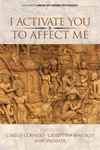
I Activate You To Affect Me
Edited by:
Carlos Cornejo, Pontificia Universidad Católica de Chile
Giuseppina Marsico, University of Salerno
Jaan Valsiner, Niels Bohr Professor of Cultural Psychology, Aalborg University
A volume in the series: Annals of Cultural Psychology. Editor(s): Giuseppina Marsico, University of Salerno. Jaan Valsiner, Niels Bohr Professor of Cultural Psychology, Aalborg University.
Published 2018
The second volume of Annals of Cultural Psychology is dedicated to the affective nature of human social relationships with the environment. The chapters here included explore the historical, theoretical and practical dimensions of the concept of affectivating originally introduced by one of us (Valsiner, 1999), as a potential tool of inquiry into the affective-sensitive dimension of psychological life within a cultural-psychological framework. The concept of affectivating involves two psychological dimensions often undervalued or even obliterated from contemporary cultural psychology, namely the affective involvement and the agentivity of people in their social encounters.
Through several examples --‘feeling-at-home’, silence spaces and rituals, memorials, music and poetry, among others-- we show individual’s concrete actions in mundane everyday life aim to give an affective personal sense to the world around. This focuses on the primary affective nature of human meaning construction that guides the person in one’s continuing feeling-into-the-world.
At a theoretical level the notion of affectivation challenges contemporary Cultural Psychology to rescue subjectivity, not only symbolism. Affectivation propounds a return to the long, but partially forgotten, organismic tradition, represented in the history by thinkers like Wilhelm Dilthey, Jakob von Uexküll and Kurt Goldstein. Cultural psychology has to bring semiosis back to the vital background of human experience.
CONTENTS
I Activate You to Affect Me: Affectivating as a Cultural Psychological Phenomenon, Carlos Cornejo, Giuseppina Marsico, and Jaan Valsiner. PART I: THEORETICAL CONSIDERATIONS AND AFFECTIVATING. Affect, Semiotics, Volition: Heteroregulation and Affectivating, Steve Larocco. Affectivating: In the Middle of Power and Pleasure in Psychology and Music, Sven Hroar Klempe. Affectivating Signs: On Semiotic Interruptions, Robert E. Innis. Commentary: Affectivating, Normativity, and Subjectivity? Lars Christian Sønderby. PART II: EVERYDAY PHENOMENA AND AFFECTIVATING. Everything Was [Not] Beautiful At the Ballet: Children Affectivating Educational Contexts Outside School, Lia da Rocha Lordelo, Anna Paula Brandão, and Camila S. M. Bezerra. “Freedom is Not Free”: Slogans Becoming Affective in Memorial Landscapes, Zachary Beckstead. Understanding Silence-Phenomena through the Boundaries of Speech: Semiotic Demand Settings Regulating Felt Experiences, Olga V. Lehmann O. An Expressive Approach to Affect and Musical Experience, Pablo Rojas. Poetics of Affectivating, Emily Abbey. Expressive Dimension of Human Experience and Affectivation Process: A Commentary on Everyday Phenomena and Affectivating Section, Pablo Fossa. PART III: PERSON–ENVIRONMENT RELATIONSHIP AND AFFECTIVATING. Affectivation: A Cut across The Semiotic Hierarchy of Feelings, Danilo Silva Guimarães. Affectivating Home Environments: Active and Affective Relations to Objects, Amrei C. Joerchel. Affectivating Environments in Creative Work, Vlad Glăveanu. Spaces, Sites, and Subjectivity: A Commentary, Wanderlene Reis and Ana Cecília Bastos. PART IV: BUILDING A GENERAL FRAMEWORK FOR AFFECTIVATING. New Theoretical and Methodological Ways in the Study of Affectivating, Leidy Evelyn Díaz Posada and Lilian Patricia Rodríguez Burgos. What is Affectivating? Elements for a Definition and Critical Comments for the Future, Alaric Kohler. Conclusions: Affectivation as a Return to Vitality, Carlos Cornejo, Giuseppina Marsico, and Jaan Valsiner. About the Editors. About the Contributors.
-
Paperback9781641130707
Web price: $45.04 (Reg. 52.99)
-
Hardcover9781641130714
Web price: $80.74 (Reg. 94.99)
- eBook9781641130721

- PSY000000 - PSYCHOLOGY: General
- PSY031000 - PSYCHOLOGY: Social Psychology
- PSY017000 - PSYCHOLOGY: Interpersonal Relations
-
 Cultural Psychology in Communities
Tensions and Transformations
Cultural Psychology in Communities
Tensions and Transformations
-
 Digital Developments
Perspectives in Psychology
Digital Developments
Perspectives in Psychology
-
 Home in Transition
The Cultural Construction of Heimat
Home in Transition
The Cultural Construction of Heimat
-
 Intimacy
The Shared Part of Me
Intimacy
The Shared Part of Me
-
 Making Meaning, Making Motherhood
Making Meaning, Making Motherhood
-
 Ordinary Things and Their Extraordinary Meanings
Ordinary Things and Their Extraordinary Meanings
-
 The Development of Social Knowledge
Towards a Cultural-individual Dialectic
The Development of Social Knowledge
Towards a Cultural-individual Dialectic

